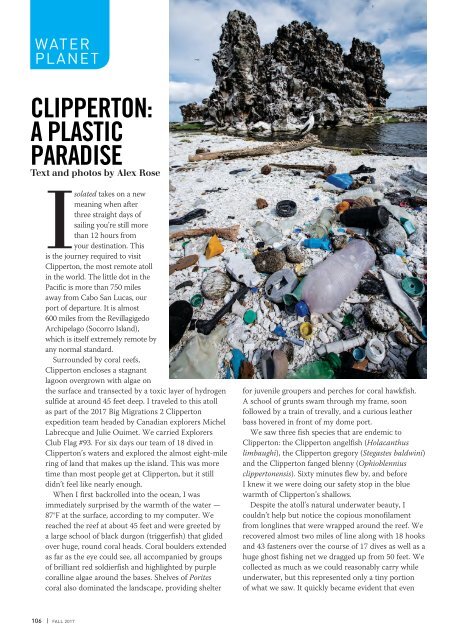AD 2017 Q4
Alert Diver is the dive industry’s leading publication. Featuring DAN’s core content of dive safety, research, education and medical information, each issue is a must-read reference, archived and shared by passionate scuba enthusiasts. In addition, Alert Diver showcases fascinating dive destinations and marine environmental topics through images from the world’s greatest underwater photographers and stories from the most experienced and eloquent dive journalists in the business.
Alert Diver is the dive industry’s leading publication. Featuring DAN’s core content of dive safety, research, education and medical information, each issue is a must-read reference, archived and shared by passionate scuba enthusiasts. In addition, Alert Diver showcases fascinating dive destinations and marine environmental topics through images from the world’s greatest underwater photographers and stories from the most experienced and eloquent dive journalists in the business.
Create successful ePaper yourself
Turn your PDF publications into a flip-book with our unique Google optimized e-Paper software.
WATER<br />
PLANET<br />
CLIPPERTON:<br />
A PLASTIC<br />
PAR<strong>AD</strong>ISE<br />
Text and photos by Alex Rose<br />
Isolated takes on a new<br />
meaning when after<br />
three straight days of<br />
sailing you’re still more<br />
than 12 hours from<br />
your destination. This<br />
is the journey required to visit<br />
Clipperton, the most remote atoll<br />
in the world. The little dot in the<br />
Pacific is more than 750 miles<br />
away from Cabo San Lucas, our<br />
port of departure. It is almost<br />
600 miles from the Revillagigedo<br />
Archipelago (Socorro Island),<br />
which is itself extremely remote by<br />
any normal standard.<br />
Surrounded by coral reefs,<br />
Clipperton encloses a stagnant<br />
lagoon overgrown with algae on<br />
the surface and transected by a toxic layer of hydrogen<br />
sulfide at around 45 feet deep. I traveled to this atoll<br />
as part of the <strong>2017</strong> Big Migrations 2 Clipperton<br />
expedition team headed by Canadian explorers Michel<br />
Labrecque and Julie Ouimet. We carried Explorers<br />
Club Flag #93. For six days our team of 18 dived in<br />
Clipperton’s waters and explored the almost eight-mile<br />
ring of land that makes up the island. This was more<br />
time than most people get at Clipperton, but it still<br />
didn’t feel like nearly enough.<br />
When I first backrolled into the ocean, I was<br />
immediately surprised by the warmth of the water —<br />
87°F at the surface, according to my computer. We<br />
reached the reef at about 45 feet and were greeted by<br />
a large school of black durgon (triggerfish) that glided<br />
over huge, round coral heads. Coral boulders extended<br />
as far as the eye could see, all accompanied by groups<br />
of brilliant red soldierfish and highlighted by purple<br />
coralline algae around the bases. Shelves of Porites<br />
coral also dominated the landscape, providing shelter<br />
for juvenile groupers and perches for coral hawkfish.<br />
A school of grunts swam through my frame, soon<br />
followed by a train of trevally, and a curious leather<br />
bass hovered in front of my dome port.<br />
We saw three fish species that are endemic to<br />
Clipperton: the Clipperton angelfish (Holacanthus<br />
limbaughi), the Clipperton gregory (Stegastes baldwini)<br />
and the Clipperton fanged blenny (Ophioblennius<br />
clippertonensis). Sixty minutes flew by, and before<br />
I knew it we were doing our safety stop in the blue<br />
warmth of Clipperton’s shallows.<br />
Despite the atoll’s natural underwater beauty, I<br />
couldn’t help but notice the copious monofilament<br />
from longlines that were wrapped around the reef. We<br />
recovered almost two miles of line along with 18 hooks<br />
and 43 fasteners over the course of 17 dives as well as a<br />
huge ghost fishing net we dragged up from 50 feet. We<br />
collected as much as we could reasonably carry while<br />
underwater, but this represented only a tiny portion<br />
of what we saw. It quickly became evident that even<br />
106 | FALL <strong>2017</strong>









